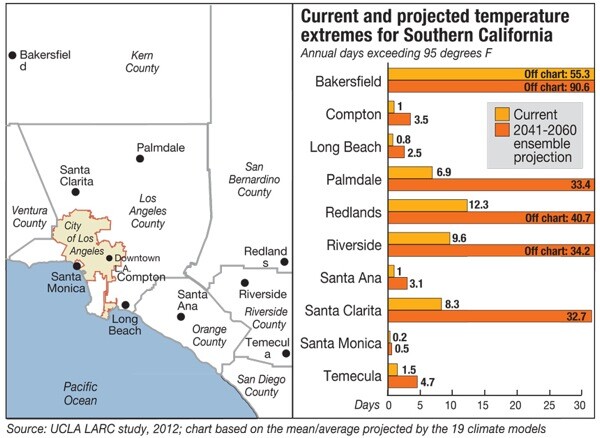Ready for Hotter Weather? Major Climate Change Study for L.A. Region Released

"It's getting hot," noted L.A. Mayor Antonio Villaraigosa before a press conference as noon approached. He was talking about today, the first full day of summer, but it just so happened that he was there to announce details found in a detailed UCLA study about climate change in the Los Angeles region.
The biggest takeaway was not that it's getting hotter -- we know that -- rather that we're not going to get cooler any time soon, no matter how much cutting of emissions we do. In other words, cutting emissions could reduce the impact of warming, but it will not stop it from happening. (Case in point: the Mayor's office released a fact sheet about adaptation. "Preparing Los Angeles for a different climate," reads one heading.)
"Even if we we drastically cut pollution worldwide, there will still be quite a bit of warming in Los Angeles," said study author Alex Hall of UCLA's Department of Atmospheric and Oceanic Sciences. "I was taken a little taken aback by how much warming remains, no matter how aggressively we cut back. It was sobering."
The first of five climate-related studies for the L.A. region, "Mid-Century Warming in the Los Angeles Reason" is being touted by UCLA as "the most sophisticated regional cilmate study ever developed." (The study has been independently reviewed and submitted to publications, meaning it hasn't gone through a stringent check yet). The big difference between this and other reports is the precision of projections for temperatures between 2041 and 2060. Instead of giving broad geographical areas, this goes down to plots about the size of one square mile.
In general, projections show average temperatures jumping three to four degrees on the coast, four degrees in downtown L.A. and the San Fernando and San Gabriel valleys, and four to five degrees in the mountain and desert areas. All this means more days in the when temperatures jump higher than 95 degrees Fahrenheit. referred to as extreme heat.
"The number of yearly hot days is the new story of Los Angeles summers and autumns," states the report, which was funded by federal stimulus dollars.

For example, downtown L.A., which usually exceeds 95 degrees 1.4 times a year, is projected to have more than four days in about 30 years. In nearby Eagle Rock, the number of these extreme heat days will jump to six from two. The most dramatic differences will be seen in the San Fernando Valley: Porter Ranch will go from eight to 30 days; from seven to 25 in Sylmar; to nearly 17 from four in Woodland Hills.
The study included all of Los Angeles and Orange counties, and portions of Ventura, Riverside, San Bernardino, and Kern counties, showing that the farther inland you go, the hotter it will likely get. The number of days exceeding 95 degrees in Bakersfield, a Central Valley city which already sees over 55 days of extreme heat, will nearly double. Palmdale in the Mojave Desert is projected to have over 33 days of extreme heat instead of the seven it currently experiences. The Inland Empire city of Redlands will go from over 12 days to close to 41.
Those hot days then translate to concern for health officials, who will need educate the public on heat-related illnesses that especially affect children and the elderly. To serve them, more cooling centers will need to be opened, which are a drain on the water and power providers, all who are facing their own climate-related problems such as a less snowpack and more demand for energy when closing down coal power plants are a stated goal.
"We are not going to completely eliminate the increase in extreme hot days," noted L.A. County Supervisor Zev Yaroslavsky. "Under the best case scenario, Los Angeles will likely have significant heat-related changes in the very foreseeable future. The responsible step for us therefore is preparing [us... to] adopt to those changes before the impacts are fully upon us."